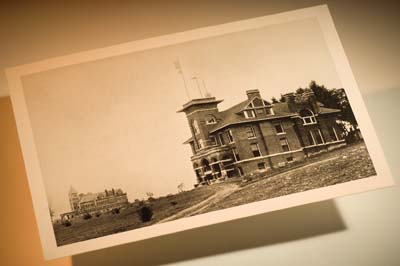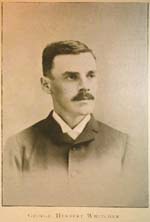 |
 |
| current issue |  |
past issues |  |
send a letter/news |  |
address update |  |
advertise |  |
about us |  |
alumni home |
On Ben's Farm
|
Weathering Heights
Blue means snow, or is it rain? For those who could keep it straight, the college's rooftop flag system helped predict the weather By Mylinda Woodward '97 |
|
 WEATHER CHANNEL: In 1895, flags on Nesmith Hall, above, signaled the forecast in a system devised by George Whitcher, below.
WEATHER CHANNEL: In 1895, flags on Nesmith Hall, above, signaled the forecast in a system devised by George Whitcher, below.
|
At the turn of the last century, Durham farmers and residents who wanted to predict the weather could rely on proverbs like "Clear moon, frost soon" and "Rainbow in the morning gives you fair warning." Or they could step outside and check the top of Nesmith Hall.
As director of the New Hampshire Agricultural Experiment Station, George Whitcher, Class of 1881—along with the new college—had moved to Durham in 1893. Within a year, he had come up with a way to use the most up-to-date weather information to provide the town with timely and accurate forecasts.
Every day, maps showing weather conditions throughout the country would arrive by train from the Boston office of the U.S. Weather Bureau. Using the maps and his own observations of local conditions, such as barometer changes, wind direction, and cloud coverage, Whitcher would predict the weather for the next three days. Every morning at 8 a.m., a staff member would climb out onto the roof of Nesmith Hall and, using a system of flags, display the forecast.

|
Four square flags indicated the weather. A white flag with a black center indicated a cold wave in winter, a frost in spring or fall. A solid white flag meant fair weather. The top flag on the staff predicted the weather for today, tomorrow's was in the middle, and so on.
In addition, a triangular black flag denoted changes in temperature. Flown above the square flags, it meant today would be warmer than the day before. Flown below, colder. No black flag? No change. Fortunately for anyone trying to remember this mind-boggling system, the signals were printed in students' handbooks, and presumably supplied to local residents as well. Whitcher sensibly recommended binoculars for anyone living at a distance. (The view was not obstructed by trees since the land had long since been cleared for farming.)
New England weather is notorious for its changeability, so when Whitcher explained the weather flag system in an issue of the Agricultural Experiment Station Bulletin, he—like weathermen everywhere—felt the need to include a disclaimer about the reliability of his predictions. "A prediction of showers does not mean that it must actually rain all over New Hampshire," he wrote, "for showers are local and while it may rain hard in one place there may be absolutely no rain at another, less than a mile away. If there are showers within sight or hearing, that is, if thunder is heard or lightning seen at night, then the prediction is verified, even though not a drop of rain has fallen in this town or in surrounding towns."
Whitcher kept no records on the accuracy of his predictions—wisely, perhaps—but his system lasted for more than 20 years.
blog comments powered by Disqus
